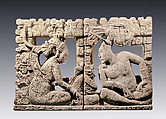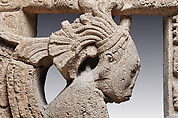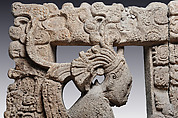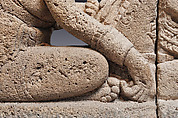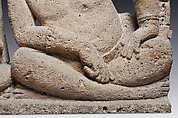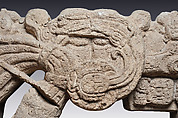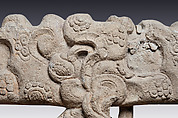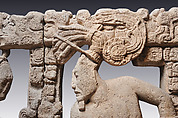Returned to lender The Met accepts temporary loans of art both for short-term exhibitions and for long-term display in its galleries.
Throne back
Not on view
Skillfully carved in silhouette on the backrest of a throne, a bearded lord and his companion observe a small supernatural creature seated between them. The diminutive figure, a messenger from the old celestial god Itzamnaaj, has a human body with winged forearms and the head of a jaguar deity. Symbols in the lord’s headdress suggest that he is impersonating Itzamnaaj while he listens to the words sent by the god himself. This visitation and performance take place in a dark mountain cave, the type of space regarded as a dwelling for the gods. Caves, and their architectural counterparts, temple chambers, were favored settings for Maya religious rituals.
Respaldo de trono
Región del río Usumacinta, Guatemala o México
Siglo VII al IX
Piedra caliza
Hábilmente labradas en el respaldo de un trono, vemos las siluetas de un hombre barbado y un acompañante observando a una pequeña criatura sobrenatural sentada entre ambos. La figurita, mensajera del dios celeste Itzamnaaj, tiene cuerpo humano con brazos alados y cabeza de deidad jaguar. Los símbolos del tocado del señor sugieren que encarna a Itzamnaaj escuchando su propio mensaje. Este acontecimiento transcurre en una cueva oscura, en la montaña, espacio considerado como morada de los dioses. Las cuevas y las cámaras de los templos –sus contrapartes arquitectónicas– eran los escenarios preferidos por los mayas para sus rituales religiosos.
This image cannot be enlarged, viewed at full screen, or downloaded.
This artwork is meant to be viewed from right to left. Scroll left to view more.
